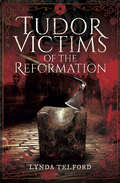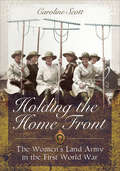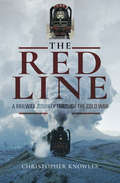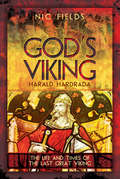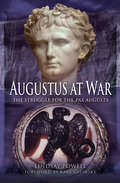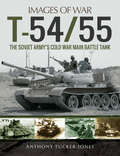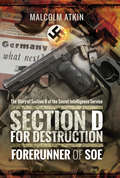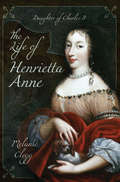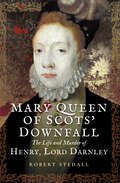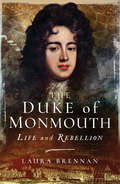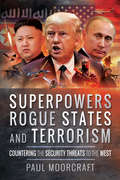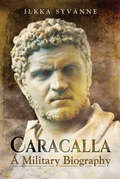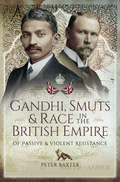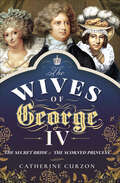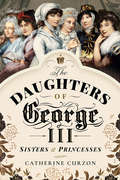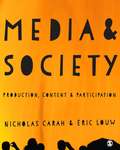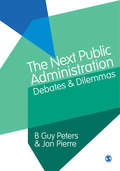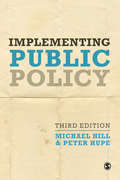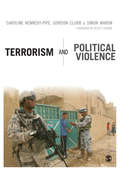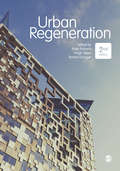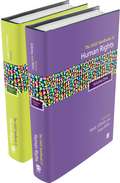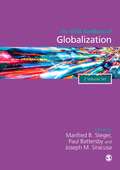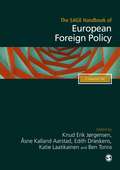- Table View
- List View
Tudor Victims of the Reformation
by Lynda TelfordThis book describes a selection of people caught up in the turmoil that presaged the reformation - a period of change instigated by a king whose desire for a legitimate son was to brutally sweep aside an entire way of life. The most famous and influential of the victims were the two people closest to Henry VIII. His mentor, Cardinal Thomas Wolsey, a great churchman and a diplomat of consummate skill. The other was to be the Kings second wife, Anne Boleyn. These two adversaries, equally determined to succeed, had risen above the usual expectations of their time. Wolsey, of humble birth, became a price of the church, enjoying his position to the full, before coming into conflict with a woman who had no intention of being another passing fancy for the king. She would become the mother of one of the greatest and most famous of Englands monarchs. They were brought down by the factions surrounding them and the selfish indifference of the man they thought they could trust. Though they succumbed to the forces aligned against them, their courage and achievements are remembered, and their places in history assured.
Holding the Home Front: The Women's Land Army in the First World War
by Caroline ScottAn &“insightful and extensive&” history of the women who took over agricultural duties in England during World War I (Sussex Living Magazine). One could be forgiven for supposing that the story of the Women&’s Land Army starts in 1939 during World War II. But it&’s a much older and more complicated history . . . British agricultural policy during the First World War was held up as a success story; domestic food production was higher at the end of the war than at the start, the average calorific value of the British diet barely changed, and bread never had to be rationed. As the press reported starvation and food riots overseas, the 1918 harvest was held up as &“one of the great achievements of the War.&” In 1917, at the darkest hour, when Britain&’s food security looked most precarious, it was said that, &“if it were not for the women agriculture would be absolutely at a standstill on many farms.&” Using previously unpublished accounts and photographs, this book is an attempt to understand how the return of women to the fields and farmyards impacted agriculture—and, in turn, an examination of how that experience affected them. &“Caroline&’s wonderful book sets the record straight with beautiful illustrations and witting testimony from people who were there and saw how hard these wonderful women worked to keep Britain going during their darkest hours. Superb.&” —Books Monthly &“This is a well-researched history of the British Women&’s Land Army in WW1 and how it paved the way for the success of the WLA in the Second World War.&” —World War One Illustrated
The Red Line: A Railway Journey Through the Cold War
by Christopher KnowlesThe Red Line is the story of a train journey from London to Hong Kong. It is set in 1981, the year Christopher made the first of twenty-four such journeys as a tour guide, when the Cold War was still very much a fact of life. Although China appeared to be on the brink of significant change, no one could know for certain; Poland was stirring but the prospect of change in the USSR and its other allies seemed remote. This made a journey by train across that landscape particularly fascinating, because by using standard, scheduled services that together created one of the longest possible railway routes, one was necessarily immersed in the various countries in ways that otherwise would have been impossible. Equally fascinating were the reactions of Western travelers to finding themselves incarcerated for weeks on end in the eccentric world behind the Iron Curtain.In order to give the journey some coherence, the most memorable events over those years have been condensed into a single journey and the most notable personalities, plucked from various times and places, have been thrown together. To emphasize the fact that these events took place in the recent past, and to be able to show how extraordinarily quickly the world has changed in the few intervening years, the story is told by a narrator. Everything that occurs is true, although some circumstances have been slightly adapted for the sake of fluency and names of individuals have been changed.
God's Viking: The Life and Times of the Last Great Viking
by Nic FieldsAn epic historical biography of the Norwegian king who laid claim to the thrones of Denmark and England.Harald Hardrada is perhaps best known as the inheritor of “seven feet of English soil” in that year of fateful change, 1066. But Stamford Bridge was the terminal point of a warring career that spanned decades and continents. Thus, prior to forcibly occupying the Norwegian throne, Harald had an interesting (and lucrative) career in the Varangian Guard, and he remains unquestionably the most notable of all the Varangians who served the Byzantine emperors. In the latter employment he saw active service in the Aegean, Sicily, Italy, Anatolia, Syria, Palestine, and Bulgaria, while in Constantinople he was the hired muscle behind a palace revolution. A man of war, his reign in Norway was to be taken up with a wasteful, vicious, and ultimately futile conflict against Denmark, a kingdom (like England) he believed was his to rule. We follow Harald’s life from Stiklestad, where aged fifteen he fought alongside his half-brother, King Olaf, through his years as a mercenary in Russia and Byzantium, then back to Norway, ending with his death in battle in England.Praise for God’s Viking“A gripping story of the last great Viking who is remembered most for his boast to the Saxons that he had come to conquer their land and ended up with just enough to contain his body . . . . Most highly recommended.” —Firetrench
Augustus at War: The Struggle for the Pax Augusta
by Lindsay PowellA penetrating assessment of Augustus as ancient Rome&’s military commander-in-chief. The words Pax Augusta—or Pax Romana—evoke a period of uninterrupted peace across the vast Roman Empire. Lindsay Powell exposes this as a fallacy. Almost every year between 31 BC and AD 14 the Roman Army was in action somewhere, either fighting enemies beyond the frontier in punitive raids or for outright conquest; or suppressing banditry or rebellions within the borders. Remarkably, over the same period, Augustus succeeded in nearly doubling the size of the Empire. How did this second-rate field commander, known to become physically ill before and during battle, achieve such extraordinary success? Did he, in fact, have a grand strategy? Powell reveals Augustus as a brilliant strategist and manager of war. As commander-in-chief (imperator) he made changes to the political and military institutions to keep the empire together, and to hold on to power himself. His genius was to build a team of loyal but semi-autonomous deputies (legati) to ensure internal security and to fight his wars for him, while claiming their achievements as his own. The book profiles more than 90 of these men, as well as the military units under their command, and the campaigns they fought. The book is lavishly illustrated with 23 maps, 42 color plates, 13 black-and-white figures and five order of battle schematics. With a foreword by Karl Galinsky, this book breaks new ground in explaining the extraordinary achievement of Caesar Augustus.
T-54/55: The Soviet Army's Cold War Main Battle Tank (Images of War)
by Anthony Tucker-JonesThe Soviet T-54/55 is probably the best-known tank of the Cold War, and it was produced in greater numbers that any other tank in history. It first went into service just after the Second World War and over 70,000 were made, and its design was so successful that it even outlasted its successor the T-62. For a generation it formed the backbone of the armored forces of the Warsaw Pact and it was exported all over the world, remaining in the front-line until the 1990s. This photographic history in the Images of War series by Anthony Tucker-Jones is the ideal introduction to it. In over 150 archive photographs and a detailed analytical text, he traces the design and development of the T-54/55 and records its operational history. He describes how it was conceived as a main battle tank, an all-rounder, contrasting with the light, medium and heavy tanks produced in the past, and it proved to be extraordinarily effective. It was as adaptable as it was long-lasting, different versions being produced by China, Czechoslovakia, Poland and Romania. Its relatively simple design also meant it was easy to maintain even in difficult conditions and it was used by armies across the Third World, in particular in wars in Angola, Ethiopia, Mozambique and Somalia. Anthony Tucker-Jones's history of this remarkable armored vehicle will be absorbing reading for tank enthusiasts and a valuable source for modelers.
Section D for Destruction: Forerunner of SOE: The Story of Section D of the Secret Intelligence Service
by Malcolm AtkinWhen Neville Chamberlain made his famous Peace in Our Time statement in 1938, after the Munich Agreement with Hitler, he may, or may not, have been aware that the new Section D of the Secret Intelligence Service was already making plans to mount an all-out political and sabotage war against Nazi Germany. This was a new form of warfare, encompassing bribery, black propaganda and sabotage by agents described as having no morals or scruples. To the horror of many, it disregarded the conventions of neutrality and was prepared to hit the Nazi state wherever it could do most damage. Malcolm Atkin reveals how Section D's struggle to build a European wide anti-Nazi resistance movement was met with widespread suspicion from government, to the extent of a systematic destruction of its reputation. It was, however, a key pioneer of irregular warfare that led to the formation of the famous Special Operations Executive (SOE). His study is the first in-depth account of it to be published since the release of previously secret documents to the National Archives.
The Life of Henrietta Anne: Daughter of Charles I
by Melanie CleggThis biography of the seventeenth-century English princess tells a sweeping tale of war and exile, marriage and scandal, and a triumphant reversal of fortune. Henrietta Anne Stuart, youngest child of Charles I and Henrietta Maria, was born in June 1644 in the besieged city of Exeter at the very height of the English Civil War. The hostilities had separated her parents, and her mother was on the run from Parliamentary forces when she gave birth with only a few attendants on hand. Within a few days she was on her way to the coast for a moonlit escape to her native France, leaving her infant daughter in the hands of trusted supporters. A few years later, Henrietta Anne would herself be whisked, disguised as a boy, out of the country and reunited with her mother in France, where she stayed for the rest of her life. But Henrietta&’s fortunes dramatically changed for the better when her brother, Charles II, was restored to the throne in 1660. After being snubbed by her cousin Louis XIV, she would eventually marry his younger brother Philippe, Duc d&’Orlans, and quickly become one of the luminaries of the French court—though there was a dark side to her rise to power and popularity when she became embroiled in love affairs with her brother-in-law Louis and her husband&’s former lover, the dashing Comte de Guiche, giving rise to several scandals and rumors about the true parentage of her three children. However, Henrietta Anne was much more than just a mere court butterfly. She also possessed considerable intelligence, wit, and political acumen, which led to her being entrusted in 1670 with the delicate negotiations for a secret treaty between her brother Charles II and cousin Louis XIV—which ensured England&’s support of France in their war against the Dutch. This is the story of her remarkable life.
Mary Queen of Scots' Downfall: The Life and Murder of Henry, Lord Darnley
by Robert StedallThe story of the Scottish ruler—and the mysterious death of her ambitious and controversial husband. In the early hours of February 10, 1567, a large explosion ripped through the lodgings at Kirk o&’ Field, Edinburgh, where Mary Queen of Scotland&’s consort, Henry, Lord Darnley, was staying. Darnley&’s body was found with that of his valet in a neighboring garden the next morning. The queen&’s husband had been murdered—and the ramifications for Mary and Scottish history would be far-reaching. Lord Darnley cuts an infamous figure in Scottish and Tudor history. In life, he proved a controversial character, and his murder at Kirk o&’ Field remains one of British history&’s great unsolved mysteries—the question of whether Mary was implicated has taxed historians ever since. In this engaging and well-researched biography, Robert Stedall reexamines Darnley&’s life and his death. His investigation brings new light and compelling conclusions to a story surrounded by political betrayal, murder, falsified evidence, and conspiracy.
The Duke of Monmouth: Life and Rebellion
by Laura BrennanHe was the illegitimate son of a king, a gallant and brave military hero, charming, handsome and well loved both within the court and with women; James Scott, Duke of Monmouth, had the life many would have envied in the seventeenth century.Monmouth lived in an age that was on the cusp of modernity. He lived through some of the biggest events and scandals of seventeenth century British history, including: the Restoration of his father, King Charles II; The Great Fire of London in 1666 and the last great plague to sweep through London killing thousands.James also experienced the political scandal of the Popish Plot; became embroiled in the foiled Rye House Plot, and was at the centre of the Exclusion Crisis, which was a major catalyst for the modern creation of our party political system.But what would turn the beloved darling of the Restoration court into a leading rebel?
Superpowers, Rogue States and Terrorism: Countering the Security Threats to the West
by Paul MoorcraftNumerous books have attempted to assess the generational threat from Jihadist-inspired terrorism but few offer any positive advice on solutions. Islamist terrorism is today a fact of life and its potency is vividly illustrated by outrages in otherwise secure Western democracies not to mention overt ISIL aggression in the Middle East and many African States. Without a far better understanding of the Islamic religion, its beliefs, value, hierarchy (or lack of) and different sects, countering the existential threat will be greatly hindered, not to say nearly impossible. In this thoughtful book the author, who combines scholarship with gritty on-the-ground experience, examines numerous options to counter the insidious threat that faces not only Western civilization but the wider world. These range from the extremes such as deportation and internment, through the multifaceted combined actions against hate preachers, intensified intelligence work and border security to comprehensive and inclusive joint action programs. This is an important and timely book on what is today the greatest security threat, written by an acknowledged expert.
Caracalla: A Military Biography
by Ilkka SyvänneThis biography of the Roman Emperor Caracalla challenges his tyrannical reputation with a revealing narrative of his social reforms and military campaigns. Caracallahas one of the worst reputations of any Roman Emperor. Many ancient historians were very hostile, and the 18th century English historian Edward Gibbon even dubbed him the common enemy of mankind. Yet his reign was considered by at least one Roman author to be the apogee of the Roman Empire. He was guilty of many murders and massacres—including that of his own brother, ex-wife and daughter. Yet he instituted the Antonine Constitution, granting citizenship to all free men in the Empire. He was also popular with the army, improving their pay and cultivating the image of sharing their hardships. Historian Ilkka Syvanne explains how the biased ancient sources in combination with the stern looking statues of the emperor have created a distorted image of the man. He then reconstructs a chronology of Caracalla&’s reign, focusing on his military campaigns and reforms, to offer a balanced view of his legacy. Caracalla offers the first complete overview of the policies, events and conflicts he oversaw and explains how and why these contributed to the military crisis of the third century.
Gandhi, Smuts & Race in the British Empire: Of Passive & Violent Resistance
by Peter BaxterTowards the end of 1906, a meeting took place between two emerging giants of the age, Mohandas K. Gandhi and General Jan Christian Smuts. United under the same empire, but separated by distance and culture, Smuts was born in the Cape Colony, and Gandhi in Porbandar, a duchy of the Indian province of Gujarat. Both, however, went on to study law in Britain, and while developing a great admiration for the institutions of empire, each man also suffered his own particular crisis of faith. From their widely dispersed origins, Gandhi and Smuts collided over the issue of race and equality in a turbulent province of the empire, each attempting to hold the British to their stated ideals. This insightful book explores attitudes to race, and belonging, in an age when the English speaking peoples straddled the globe, and sought to impose on all of their subject races, basking under the radiance of Britannia, a common ideal of parity, equal opportunity and free movement.
The Wives of George IV: The Secret Bride & the Scorned Princess
by Catherine CurzonThe scandalous life of George IV is revealed in this account of his marriage to Princess Caroline and his secret union with a longtime mistress. In Georgian England, few men were more eligible than the Prince of Wales. The heir to George III&’s throne would seem to be an excellent catch. Though the two women who married him might beg to differ. Maria Fitzherbert was a twice-widowed Roman Catholic with a natural aversion to trouble. When she married the prince in a secret ceremony, she opened the door on three decades of heartbreak. Cast aside by her husband one minute, pursued by him tirelessly the next, Maria&’s clandestine marriage was anything but blissful. It was also the worst kept secret in England. Caroline of Brunswick was George&’s official bride. Little did she know that her husband was marrying for money. When she arrived for the ceremony, she found him so drunk that he couldn&’t even walk to the altar. Caroline might not have her husband&’s love, but the public adored her. In a world where radicalism was stirring, it was a recipe for disaster. In The Wives of George IV, Maria and Caroline navigate the choppy waters of marriage to the capricious, womanizing king-in-waiting. With a queen on trial for adultery and the succession itself in the balance, Britain had never seen scandal like it.
The Daughters of George III: Sisters & Princesses
by Catherine CurzonAn in-depth look into the lives of the six daughters of King George III of England.In the dying years of the 18th century, the corridors of Windsor echoed to the footsteps of six princesses. They were Charlotte, Augusta, Elizabeth, Mary, Sophia, and Amelia, the daughters of King George III and Queen Charlotte of Mecklenburg-Strelitz. Though more than fifteen years divided the births of the eldest sister from the youngest, these princesses all shared a longing for escape. Faced with their father’s illness and their mother’s dominance, for all but one a life away from the seclusion of the royal household seemed like an unobtainable dream.The six daughters of George III were raised to be young ladies and each in her time was one of the most eligible women in the world. Tutored in the arts of royal womanhood, they were trained from infancy in the skills vital to a regal wife but as the king’s illness ravaged him, husbands and opportunities slipped away.Yet even in isolation, the lives of the princesses were filled with incident. From secret romances to dashing equerries, rumors of pregnancy, clandestine marriage and even a run-in with Napoleon, each princess was the leading lady in her own story, whether tragic or inspirational. In The Daughters of GeorgeIII, take a wander through the hallways of the royal palaces, where the king’s endless ravings echo deep into the night and his daughters strive to be recognized not just as princesses, but as women too.Praise for The Daughters of George III“This fascinating look at the lives and times of the six daughters of George III and Queen Charlotte delivers an engaging read for enthusiasts of the royals and British history.” —Library Journal
The Daughters of George III: Sisters & Princesses
by Catherine CurzonAn in-depth look into the lives of the six daughters of King George III of England.In the dying years of the 18th century, the corridors of Windsor echoed to the footsteps of six princesses. They were Charlotte, Augusta, Elizabeth, Mary, Sophia, and Amelia, the daughters of King George III and Queen Charlotte of Mecklenburg-Strelitz. Though more than fifteen years divided the births of the eldest sister from the youngest, these princesses all shared a longing for escape. Faced with their father’s illness and their mother’s dominance, for all but one a life away from the seclusion of the royal household seemed like an unobtainable dream.The six daughters of George III were raised to be young ladies and each in her time was one of the most eligible women in the world. Tutored in the arts of royal womanhood, they were trained from infancy in the skills vital to a regal wife but as the king’s illness ravaged him, husbands and opportunities slipped away.Yet even in isolation, the lives of the princesses were filled with incident. From secret romances to dashing equerries, rumors of pregnancy, clandestine marriage and even a run-in with Napoleon, each princess was the leading lady in her own story, whether tragic or inspirational. In The Daughters of GeorgeIII, take a wander through the hallways of the royal palaces, where the king’s endless ravings echo deep into the night and his daughters strive to be recognized not just as princesses, but as women too.Praise for The Daughters of George III“This fascinating look at the lives and times of the six daughters of George III and Queen Charlotte delivers an engaging read for enthusiasts of the royals and British history.” —Library Journal
Media and Society: Production, Content and Participation
by Nicholas Carah Eric Louw'This is the media and society text that critical scholars have been waiting for'. - Professor Mark Andrejevic, Pomona College This book unpacks the role of the media in social, cultural and political contexts and encourages you to reflect on the power relationships that are formed as a result. Structured around the three cornerstones of media studies; production, content and participation, this is an ideal introduction to your studies in media, culture and society. The book: Evaluates recent developments in media production, industries and platforms brought about the emergence of interactive media technologies. Examines the shifting relationship between media production and consumption instigated by the rise of social and mobile media, recasting consumption as ‘participation’. Explores the construction of texts and meanings via media representations, consumer culture and popular culture, as well as the relationship between politics and public relations. Assesses the debates around the creative and cultural labour involved in meaning-making. Includes a companion website featuring exercise and discussion questions, links to relevant blogs and web material, lists of further reading and free access to key journal articles.
The Next Public Administration: Debates and Dilemmas
by Jon Pierre B. Guy PetersWritten by two of the leading scholars in the field, this book explores public administration in the past, present and future, critically reviewing the modernization of public management reform. It reasserts public administration as an integral component of democratic governance and fostering a state-citizen relationship. Wide-ranging in scope, The Next Public Administration: Extends basic public administration to consider issues associated with management, governance and democracy Covers core public administration concepts and their evolution through time Draws on an international spread of examples, bringing theoretical discussions to life Includes lists of further reading Essential reading for students of public management and public administration.
Implementing Public Policy: An Introduction to the Study of Operational Governance (Sage Politics Texts)
by Michael Hill Peter HupeBuilding on the success of the previous two editions, this book provides students with an exemplary overview of the theory and practice of public policy implementation and how it relates to contemporary public management. In doing so, this new edition makes use of more illustrative examples, delves further into researching implementation and explores issues about the relationship between policy formulation and implementation in greater depth. Written for an international audience, this is essential reading for upper-level undergraduate and graduate students studying or conducting research in public policy, social policy, public management, public administration and governance.
Terrorism and Political Violence
by Simon Mabon Gordon Clubb Caroline Kennedy-PipeThis book introduces you to the key issues in contemporary studies on Terrorism. Its interdisciplinary approach provides a unique intellectual rigour which introduces readers to cutting-edge research. Bringing together chapters contributed by members of the Terrorism and Political Violence Association network, it offers an insight into a variety of traditional and critical perspectives. It also equips Undergraduate and Postgraduate students with the study skills needed to succeed in coursework and assignments, especially dissertation work. Drawing on the expertise of TAPVA members, this book: Explores contemporary issues, such as drone warfare, state violence, children and political violence, cyber-terrorism and de-radicalisation. Features case studies drawn from a range of international examples, lists of further reading, key concepts and questions for use in seminars and private study. Provides you with study skills content designed to help you complete your dissertation. This is the perfect textbook to guide you through your studies in terrorism, political violence, international security and strategic studies.
Terrorism and Political Violence
by Caroline Kennedy-Pipe Gordon Clubb Simon MabonThis book introduces you to the key issues in contemporary studies on Terrorism. Its interdisciplinary approach provides a unique intellectual rigour which introduces readers to cutting-edge research. Bringing together chapters contributed by members of the Terrorism and Political Violence Association network, it offers an insight into a variety of traditional and critical perspectives. It also equips Undergraduate and Postgraduate students with the study skills needed to succeed in coursework and assignments, especially dissertation work. Drawing on the expertise of TAPVA members, this book: Explores contemporary issues, such as drone warfare, state violence, children and political violence, cyber-terrorism and de-radicalisation. Features case studies drawn from a range of international examples, lists of further reading, key concepts and questions for use in seminars and private study. Provides you with study skills content designed to help you complete your dissertation. This is the perfect textbook to guide you through your studies in terrorism, political violence, international security and strategic studies.
Urban Regeneration
by Professor Peter Roberts Sir Hugh Sykes Rachel GrangerUrban Regeneration is widely discussed but less widely understood. Fully revised with important new policy, case studies and international analysis, the Second Edition of Urban Regeneration will correct that. The 16 chapters, written by leading experts, are organised into four sections: The Context for Urban Regeneration: The history and evolution Major Themes and Topics: Including Housing, Community, Employment and the Environment Key Issues in Managing Urban Regeneration: Including Legal and Organisational considerations Experience Elsewhere and a View of the Future: Expanded section now discussing Australia and the Celtic Fringe as well as Europe and the USA This is the essential handbook for practitioners involved in regeneration, as well as students of planning, urban studies, geography and architecture.
The SAGE Handbook of Human Rights: Two Volume Set
by Anja Mihr Mark GibneyThe SAGE Handbook of Human Rights will comprise a two volume set consisting of more than 50 original chapters that clarify and analyze human rights issues of both contemporary and future importance. The Handbook will take an inter-disciplinary approach, combining work in such traditional fields as law, political science and philosophy with such non-traditional subjects as climate change, demography, economics, geography, urban studies, mass communication, and business and marketing. In addition, one of the aspects of mainstreaming is the manner in which human rights has come to play a prominent role in popular culture, and there will be a section on human rights in art, film, music and literature. Not only will the Handbook provide a state of the art analysis of the discipline that addresses the history and development of human rights standards and its movements, mechanisms and institutions, but it will seek to go beyond this and produce a book that will help lead to prospective thinking.
The SAGE Handbook of Globalization
by Professor Manfred B. Steger Paul Battersby Professor Joseph M SiracusaGlobal studies is a fresh and dynamic discipline area that promises to reinvigorate undergraduate and postgraduate education in the social sciences and humanities. In the Australian context, the interdisciplinary pedagogy that defines global studies is gaining wider acceptance as a coherent and necessary approach to the study of global change. Through the Global Studies Consortium (GSC), this new discipline is forming around an impressive body of international scholars who define their expertise in global terms. The GSC paves the way for the expansion of global studies programs internationally and for the development of teaching and research collaboration on a global scale. Mark Juergensmeyer and Helmut Anheier’s forthcoming Encyclopaedia of Global Studies with SAGE is evidence of this growing international collaboration, while the work of Professor Manfred Steger exemplifies the flourishing academic literature on globalization. RMIT University’s Global Cities Institute represents a substantial institutional investment in interdisciplinary research into the social and environmental implications of globalization in which it leads the way internationally. Given these developments, the time is right for a book series that draws together diverse scholarship in global studies. This Handbook allows for extended treatment of critical issues that are of major interest to researchers and students in this emerging field. The topics covered speak to an interdisciplinary approach to the study of global issues that reaches well beyond the confines of international relations and political science to encompass sociology, anthropology, history, media and cultural studies, economics and governance, environmental sustainability, international law and criminal justice. Specially commissioned chapters explore diverse subjects from a global vantage point and all deliberately cohere around core “global” concerns of narrative, praxis, space and place. This integrated approach sets the Handbook apart from its competitors and distinguishes Global Studies as the most equipped academic discipline with which to address the scope and pace of global change in the 21st century.
The SAGE Handbook of European Foreign Policy
by Professor Ben Tonra Dr Katie Laatikainen Professor Edith Drieskens Knud Erik Jorgensen Ms Aasne Kalland AarstadDuring the last two decades the study of European foreign policy has experienced remarkable growth, presumably reflecting a more significant international role of the European Union. The Union has significantly expanded its policy portfolio and though empty symbolic politics still exists, the Union’s international relations have become more substantial and its foreign policy more focused. European foreign policy has become a dynamic policy area, being adapted to changing challenges and environments, such as the Arab Spring, new emerging economies/powers; the crisis of multilateralism and much more. The SAGE Handbook of European Foreign Policy, Two-Volume set, is a major reference work for Foreign Policy Programmes around the world. The Handbook is designed to be accessible to graduate and postgraduate students in a wide variety of disciplines across the humanities and social sciences. Both volumes are structured to address areas of critical concern to scholars at the cutting edge of all major dimensions of foreign policy. The volumes are composed of original chapters written specifically to the following themes: · Research traditions and historical experience · Theoretical perspectives · EU actors · State actors · Societal actors · The politics of European foreign policy · Bilateral relations · Relations with multilateral institutions · Individual policies · Transnational challenges The Handbook will be an essential reference for both advanced students and scholars.
